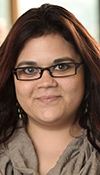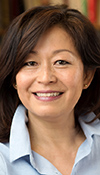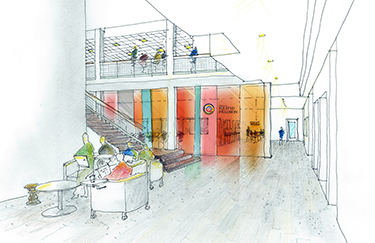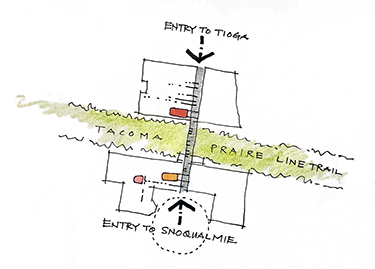|
Subscribe / Renew |
|
|
Contact Us |
|
| ► Subscribe to our Free Weekly Newsletter | |
| home | Welcome, sign in or click here to subscribe. | login |
Construction
| |
 |
August 27, 2020
UWT project focuses on equity, justice and design

Bose
|

Shin
|
This year has brought renewed attention to inequities deeply rooted in our society. These inequities cut through all aspects of our lives, including architecture and equal access to shared spaces. Architectural design and the design process have a unique opportunity to respond to and help promote change towards a more equitable and just society.
The University of Washington Tacoma (UWT) is bringing together three units on the downtown campus into a Learning Commons with the intention of being an agent of such change. These three units are the Center for Equity and Inclusion (CEI), the Teaching and Learning Center (TLC), the UW Tacoma Library. A new technology hub will be created in this space and managed by the Library. This new Learning Commons focuses on inclusion, integrated learning, knowledge and technology in equal parts to infuse the university’s core values into the buildings at the heart of campus.
Bringing together these diverse program types and designing purposefully democratic educational spaces for today requires an inclusive design process, with curiosity for the diverse lived experiences of students and an awareness of the historical cultural context of the place.
Inclusion in the design process
Throughout the planning and design phases, McGranahan sought to engage the people we are designing for, to hear and understand their interaction with the university.
In these in-person and online meetings, it was not about the questions that we-as-the-architect asked, but that we-as-the-whole-team developed a sense of trust and belonging. We had to create a psychologically safe environment by setting some ground rules for all our meetings in order to be this vulnerable with each other.
From the beginning, our intent was to include as many voices in the process as possible and give them equal weight. All opinions and perspectives were respected, and every conversation was approached with curiosity. We would conclude each meeting with “Wows and Wonders” (a quick roundtable method of recalling highlights from the meeting) to make sure everyone’s voice was heard. These meeting practices require time, discipline and sometimes a bit of awkwardness to establish in a group, but it is worth the effort for projects of all sizes/scales. For a project as complex as the Learning Commons, with so many unique units coming together, it was essential to slow down the process and truly hear everyone’s point of view.
The relationships that were formed through this process not only informed the design but have shaped connections between the units. As the narrative and floor plans developed, the mindset of the group shifted towards one of partnership and collaboration, which will inevitably flow into the spaces created from the drawings.
Connecting people and place
As with any project, we heard about the many services offered by each program and the current challenges they face; however, with this project, we also heard about the cultural and historical connections that run throughout campus and the surrounding community. These connections enforce the feeling of belonging, so it was essential to understand and create space for them.
Most students commute to this campus, so the Learning Commons is one of the few shared spaces where all students find a common university experience. The UWT student population is diverse in ethnic and family backgrounds, age, interests and experience levels. First generation college students make up more than half the student population. There is a kaleidoscope of perspectives and needs on the UWT campus.
UW Tacoma is an urban university that opened in 1997, located in the heart of the city’s historic warehouse district. It is physically tied to Tacoma’s 19th century emergence as the terminus of the Northern Pacific Railroad. This railroad was built by Chinese migrant laborers who were not allowed to make their homes in Tacoma. Many of the buildings that UWT inhabits today were originally used as commercial business buildings because of their proximity to the terminus, including a vibrant community of Japanese-owned businesses that were lost to the internment of Japanese people during WWII.
In the larger context of Tacoma, UWT resides within and acknowledges the territory where the Puyallup people lived for thousands of years. It also must grapple with the redlined neighborhoods that have a lasting mark on Tacoma to this day.
Design response — access for all
This is a small project, rich with design opportunities and challenges, but the inclusive and engaging process has allowed us to listen to all stakeholders, see through their lenses, and give birth to a UWT HUB — a Learning Commons with efficient solutions including these three design moves:
• Relocation of CEI and technology lab/maker space on to the first floor of the main entry.
• Navigation “spine” connecting all four units with a “one-stop-shop” main desk and other resource-specific check-in desks.
• Variety of active learning, flexible and open spaces for all.
Relocating the CEI to the first floor of the new Learning Commons will complete the university’s vision of creating a welcoming campus for all students. At the beginning of the design process, the Center for Equity and Inclusion asked the design-build team, the university leadership, and the other units to trust that they could anchor the whole program by placing them prominently on the first-floor near the main entry to the Learning Commons. This was a highly coveted location, which evolved through many conversations and design iterations. As we arrived at the iteration where the CEI and the new technology hub hold the first floor, the whole project started to come into focus.
The CEI is a natural connector already creating joint programming with other units. They give space where historically marginalized communities can be in closer proximity to one another while maintaining a sense of their own space. They celebrate belonging and culture where everyone can participate. In addition to this, co-locating the technology lab/maker space with the CEI creates a 21st century Learning Commons where equal access is a priority.
Enhancing the navigation experience was one of the clients’ primary goals. The new “spine” — connecting the buildings and the service points of all four units — provides logical wayfinding, clear sightlines and a welcoming experience. The spine also functions as a curated gallery space to showcase local histories, diverse community stories and UWT-focused projects.
It was important to students, staff and faculty to reflect on and consciously transform the way they want to learn, study and engage in this new space. The environment will be open, connecting to both natural light and campus views. A variety of furniture types, reservable study rooms and active learning spaces addresses the community’s diverse and unique learning styles. There will be a prayer and meditation space with an ablution sink for ritual washing. This space was designed with the help of the Muslim Student Association and can be reserved by any group needing a place to express their personal beliefs.
Bringing together unique services and resources, while also honoring history and lived experiences, has allowed us to create a welcoming hub for diverse learners to navigate integrated services, technology-rich resources and safe physical spaces. As a result of these new conversations and partnerships, the Learning Commons as a built environment will embody UWT values and place knowledge, learning and inclusion at the heart of this historic campus.
Seong Shin is a director of interior design and Shona Bose is a project designer, both with McGranahan Architects.
Other Stories:
- Building schools is about building communities
- Learning inside and outside the box
- First U.S. net zero school has 10-year checkup
- How the pandemic can change education for the better
- Eastside school’s HVAC system zaps the bad stuff
- Idaho school master plan takes on Living Building Challenge
- Community engagement drives design for Tacoma school
- Modular classrooms are a quick study in filling vital needs
- Modified mechanical systems for healthier schools
- Students get a boost from outdoor connections




